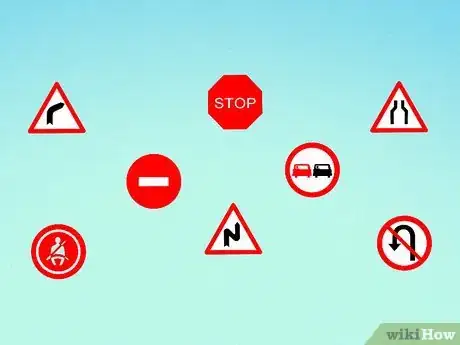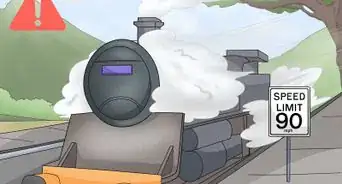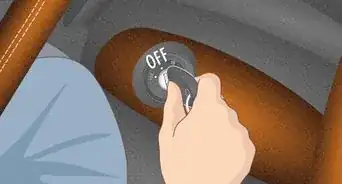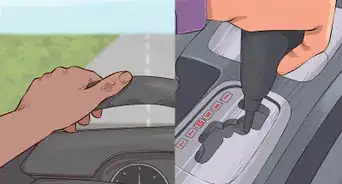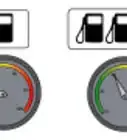This article was co-authored by Simon Miyerov. Simon Miyerov is the President and Driving Instructor for Drive Rite Academy, a driving academy based out of New York City. Simon has over 8 years of driving instruction experience. His mission is to ensure the safety of everyday drivers and continue to make New York a safer and efficient driving environment.
wikiHow marks an article as reader-approved once it receives enough positive feedback. This article has 25 testimonials from our readers, earning it our reader-approved status.
This article has been viewed 1,594,552 times.
Driving is one of the most useful skills in the world. But before you begin to drive, remember that driving is a privilege, not a right, and that you should learn how to be a responsible driver before you put your keys in the ignition. All of the rules and regulations of driving can feel overwhelming, but if you take them one step at a time, you'll be a pro on the road in no time. Read on to find out how to drive.
Steps
Getting Started
-
1Learn the driving rules for your location. Before you get a permit, it's important to be aware of the rules of driving and the basic safety precautions you should take as a responsible driver. It's much more advisable to learn the rules before you get behind the wheel so you don't wing it and make mistakes as you go along.[1] Here's how:
- Read the driver's handbook provided by the DMV or your local department that regulates driving and automobiles. This may be found online on the official government website. If you do not learn the rules, you won't be able to get your permit.
- Some basic rules and common-sense safety precautions that everyone should know include: stopping for pedestrians, obeying traffic signs, staying within the speed limit, handling emergencies, and wearing your seatbelt.
-
2Get your learner's permit. A learner's permit allows you to drive under the supervision of an experienced driver who has a valid driver's license for the vehicle you will use to practice. All states require you to pass a knowledge test before issuing your permit. The minimum age for a learner's permit in most states is 16, some have it at 15, and only a few at 14 so check with your state's requirements.[2] Here are some general guidelines:
- Most states only allow you to practice driving with an adult age 21 or over. Only a few states allow you to legally practice with someone younger than 21.
- Most states also have a curfew for permit drivers. You cannot drive at night regardless if you are accompanied.
- If you're a minor, you'll need the signature of your parent or guardian before you can commence your driving.
- You'll have to pass a written test about driving rules and regulation and safety on the road.
- Some jurisdictions will require a certain number of hours of “behind-the-wheel” driver’s education in order to get your license.
- If you are still in school, your school may offer classes in driver's education.
- Depending on the jurisdiction, your learner's permit may only be valid after you start behind-the-wheel lessons. In other jurisdictions, your learner's permit is only valid during behind-the-wheel lessons.
- Certain jurisdictions require the placement of an "L" (learner), "Student Driver", "New Driver", or the shoshinsha mark (🔰) on the back of your vehicle during driving practice and/or for the first year after you get your learner's permit or driver's license. You can be ticketed if these are absent.
Advertisement -
3Practice driving. Once you have your permit, you need to hone your driving skills. Before you take your car on the highway, you need to practice getting comfortable behind the wheel. Take it one day at a time and be patient. Nobody's a perfect driver at first. Here are some tips:
- Practice with an adult that you trust. Drive with a responsible driver over the age of majority who can guide you and give you advice without getting frustrated. By law, the adult may have to sit in the front seat and have gotten their license. The adult must also be in a position to instruct, and, depending on the jurisdiction, the vehicle might need dual-controls (second brake pedal).
- Practice in an isolated and safe location, such as an empty parking lot on the weekends. This will help you understand the way your car accelerates, how your brakes work, and how to generally maneuver your car. Each car is different and it's important to get a feel for what makes your car unique.
- While in some jurisdictions you can practice at the test site, in other jurisdictions you are not allowed to practice driving on the road test course.
Preparing to Drive Safely
-
1Make the proper adjustments. Before you start driving, it's important to adjust your mirrors and seat so that you are ready for the road. Doing this before you drive instead of while you're driving will ensure that you stay safe and focused.[3] Here's what to do:
- Check your rearview and side mirrors and make any necessary adjustments. Make sure you have a good view of the cars on either side and behind you. Do not adjust your mirrors while driving---this can be far too distracting.
-
2Make sure you and your car are ready to go. Before you put your hands on the wheel, it's important that your body and car are ready to venture out onto the roads. Here's what you should do:
- Lock all your doors. This will prevent unwanted people from entering your vehicle (i.e. carjackers) and reduce the chance of the doors inadvertently opening in the midst of a collision.
- Fasten your seatbelt. Depending on where you live, there is most likely a law that requires you wear a seatbelt. Not only can you get cited for breaking this rule, but your chances of injury and fatality during a collision also increase exponentially.
- Check your dashboard. Make sure your car is ready to drive and that there are no alarming lights that signal that your car needs to be taken to the shop.
- Adjust your seat, making sure you can comfortably reach the pedals and see the road.
-
3Minimize distractions. To be safe, you should minimize any distractions before you put your foot to the pedal. Eliminate any obstacles that will keep you from focusing on the road. Here are some tips:
- Put away your cell phone. Don't get behind the wheel if you're in the middle of an intense texting session with your best friend. Finish the conversation by saying you're going to drive and will talk later. You can even turn off your phone if you're prone to distractions.
- Turn down your music. Put on something soothing and relaxing to get you focused.
- If you need to brush your hair or put on makeup, do not do this while driving--get everything you need to do done before you put the keys in the ignition.
Driving an Automatic Car
-
1Start your car. To start your car, you have to follow a few easy steps in the right order. Here's what you do:
- Put your key in the ignition and turn it. You should hear it turning on.
- Put your foot on the brake.
- Release the handbrake.
-
2Place your car into gear. Since you are learning on an automatic, this will either be (D) Drive or (R) Reverse, depending on how you are parked.
- If you're driving forward, you should put your car in Drive.
- If you're driving backward, in order to back out of a driveway or a parking spot, your car should be in Reverse.
- If reversing, first check your rearview mirror and then place your hand on the passenger seat as you turn your head to the right to look behind you.
-
3Take your foot off the brake (pivot) and feel the car move. Congratulations--you are driving a car!
- Slowly apply your foot to the gas to accelerate.
-
4Accelerate your car. You should accelerate your car to reach the speed limit in your neighborhood. If you're on the highway, you should be aware of the speed limit but go with the flow of traffic.
- If all the cars around you are going much slower than the speed limit due to traffic, drive accordingly to avoid crashing into them.
- If all of the cars around you are driving much faster than the speed limit, you don't have to break the law, but you can accelerate a bit so you don't slow the flow down too much.
- Remember that driving too slow can be just as dangerous as driving too fast.
- Accelerate your car calmly. Don't push your foot too hard on the gas or you may go much faster than you intended. Know that each car has its own acceleration rate.
-
5Steer your car properly. Proper steering techniques will make your driving experience smoother and will help you avoid collisions. Steering your car the right way can help you turn and position in your car in the most convenient way. Here are some tips for good steering:
- Make sure to have both hands on the wheel.
- Place your hands at either 8 or 4 o’clock, slightly higher at 9 and 3 o’clock or at 10 and 2 o'clock, depending on your preference. At this position, you can safely maneuver the wheel and are prevented from making any sharp turns.
- When making a turn, pull down on the side of the wheel you wish to turn towards and push up with opposite hand. This is called “pull-push” steering.
- To make sharper turns at lower speeds, use hand-over-hand turning. To do this, perform a push-pull turn but bring your pull hand over your push hand in order to continue moving the wheel in the desired direction.[4]
-
6Understand your brakes. You should know how long it takes for your car to reach a full and complete stop when traveling at various speeds.
- Always drive at least a car length behind the car in front of you. If you have to make a fast stop, you do not want to crash into the front car.
- When traveling at a faster speed, you will need even more than one car length in order to come safely to a stop, so understand and observe the two-second rule, which states that you should be at least two seconds behind any car directly in front of you to keep a safe following distance. Take weather and road conditions into account.
- Try not to stop suddenly unless it’s an emergency. Sudden stops can lead to vehicles behind you plowing into your rear.
-
7Signal appropriately. Remember that the person in the car behind you cannot read your mind. They don't know which direction you are going to move unless you signal.You should signal in the following situations:[5] :
- As you approach the last 100 feet (30.5 m) before your turning point (left or right turn).
- Before you change lanes, be sure that you signal at least 5 to 6 seconds prior.
- Before pulling into or out from a curbside parking spot.
- When changing directions.
-
8Use your lights. Your car lights can help you see more clearly and avoid danger. You should use them when it's dark, raining, or foggy.
- A general rule of thumb is if you have to ask yourself, "Should my lights be on right now?" then the answer is always yes.
- Check the other cars on the road. If most of them turn their lights on, flick yours on too.
- Remember that some cars have lights that automatically turn on and off under certain conditions. If you don't have one of these types of cars, make sure to turn your lights off when you park your car, or you may drain your battery.
-
9Use your wipers. Learn how your windshield wipers work before the first drop of rain falls. You can adjust them to move back and forth at different speeds depending on how hard the rain is falling.
- Recognize that there are some states that require your full-headlights to be on when you run the wipes from anything between intermittent speed and faster.
- Some wipers can squirt fluid on your windshield to wipe off any dirt or stains.
- Do not drive if your wipers are broken. Driving in a storm without wipers is incredibly dangerous.
-
10Change lanes like a pro. Follow the rules for properly and safely changing lanes. A useful mnemonic device to follow is S.M.O.G.[6]
- S: SIGNAL to let the cars around you know that you intend to change lanes.
- M: Check your MIRROR to see that it is clear.
- O: Check OVER-THE-SHOULDER to again make sure that it is safe to proceed.
- G: GO.
-
11Park your car correctly. After you've reached your destination, you'll need to turn off your engine and park your car safely. Here's how to finish driving:
- Find a good parking spot, and stop your car by putting your foot on the brake.
- Shift gears into "Park."
- Turn off your engine.
- Pull up your parking brake.
- If your lights are on, turn them off.
- Lock your car to prevent theft.
- Get out of the car and make sure it fits in its spot.
Learning on a Manual Car
-
1Remember that many basic rules of driving apply to both automatic and manual cars. Though the differences between the cars will be discussed, there are many basic rules that still apply to both types of cars. They are:
- The steps you should take to prepare for driving, such as adjusting your mirrors and avoiding distractions.
- The rules of signaling appropriately.
- The rules of changing lanes.
- Using your lights and wipers when needed.
- The placement of your hands on the wheel.
-
2Learn the controls. Most people will agree that the manual car is trickier to drive than the automatic because of the extra steps that need to be taken to drive successfully. However, many people also say that driving a manual car can be more fun and rewarding, because you'll be more involved in the driving process. If you have a manual car, you should recognize and use two extra controls. They are:
- The clutch: The clutch controls the connection between the engine and transmission. Pushing on the clutch pedal disengages the clutch and disconnects the engine from the transmission. Releasing will engage the clutch and connect them. When disengaging the clutch, you effectively place the car in neutral regardless of whether it is in gear or not. Engaging the clutch will place the car into whichever gear is currently selected.
- The shifter: Shifting gears is done by moving a stick called either the gear stick, shift stick, gearshift, gear lever, gear selector, or shifter. Gear numbers and shift patterns will vary by model but the “default” position is “N” neutral, followed by gears that range from 1 to 5 or 1 to 6, and then “R” reverse.
-
3Start the car. Starting your manual car is a bit trickier than starting an automatic car. It will also take more practice. When you're starting out, make sure you're in an isolated location to prevent any problems. Here's how to do it:
- Begin by stepping on the clutch. Most manual cars will not start unless the clutch is disengaged.
- Once you have started the car, place your foot on the brake and release the emergency brake.
- If moving forward, place the car into 1st gear. If reversing, place the car into reverse ("R").
- As you slowly release the clutch, slowly apply pressure onto the gas pedal.
- You will hear the engine revving up and then feel and hear the clutch “catch.” If the car moves forward without the engine stalling, then great work! You have successfully started the car and are traveling in 1st gear.
-
4Switch your gears to match your speed. Shift gears just as you would from Neutral to 1st gear in order to move into the higher gears. Before you start switching gears, remember these points:
- You must shift gears in this order. Disengage the clutch by pressing on the clutch pedal. Shift gears using the shifter. Re-engage the clutch by slowly taking pressure off the clutch pedal while stepping on the gas.
- Think of the clutch pedal and gas pedal as being proportionate to the other in pressure. They should act in concert together in the same way that a see-saw behaves. When one goes up, the other goes down.
- Gradually applying gas while engaging the clutch will make shifting gears smoother. It will take time, but once you master the feeling of the clutch and gas, it will become second nature.
-
5Move into higher gears for higher speed. Each car will have its own speed range for each gear. Some will tell you to only switch gears after reaching a certain RPM.
- Listen to your car and switch when you think the engine needs to make the change.
-
6Brake appropriately. Press on the clutch pedal and move into Neutral when braking. Moving the car into Neutral will ensure that the engine is no longer moving the transmission and prevents you from stalling as you decelerate with the brake.
- You can potentially save gas and improve the life of your brakes by downshifting to decelerate. This takes practice however, so begin by just using your brakes.
-
7Park your car. Once you've found the right place to park your car, it's important to follow a few key rules to park your manual car properly. Here's what you should do:
- Leave your car in gear, not Neutral. It'll typically be in either reverse or first gear. If you leave it in Neutral, it won't stay put.
- Take your keys out of the ignition.
Getting Your License
-
1Take the appropriate steps to receive a license. Once you've gotten your permit, have mastered either the automatic or manual car, and have driven on the road for the requisite amount of time (six months in some states), then you are ready to get your driver's license! The driver's license will allow you to drive alone, at any hour, and with more than one other person in the car. To get the license, there are a few things you may have to do, depending on your state:
- Pass a written test.
- Pass a short driving test, which will test you on basic driving skills which include how to parallel park and make K-turns.
- Pass a vision test.
- Check out your state's DMV requirements to see exactly how old you have to be and what you have to do to get a license.
-
2Remember that driving is a privilege, not a right. Once you've done everything you need to do to get your license, you should remember to be a cautious, safe, or responsible driver. If you don't drive by the rules, your driving privileges will be revoked and you may get in trouble with the law. Here are some things to keep in mind once you're a licensed driver:
- Always put safety first. Safety should be your priority over fun. Don't do anything that compromises your safety like cram seven people in your car, drive without a seat-belt, or be a generally distracted driver.
- Your driving skills can always be improved. Make notes of things you want to work on, from making smooth turns to signaling ahead of time, and work to address your driving flaws.
- Keep your passengers safe. Make sure your passengers are behaving appropriately before you start the car. If they are hanging out of windows, not wearing seat-belts, or not respecting the roads, don't start the car.
Expert Q&A
Did you know you can get expert answers for this article?
Unlock expert answers by supporting wikiHow
-
QuestionWhat's the difference between an automatic and semi-automatic car?
 Simon MiyerovSimon Miyerov is the President and Driving Instructor for Drive Rite Academy, a driving academy based out of New York City. Simon has over 8 years of driving instruction experience. His mission is to ensure the safety of everyday drivers and continue to make New York a safer and efficient driving environment.
Simon MiyerovSimon Miyerov is the President and Driving Instructor for Drive Rite Academy, a driving academy based out of New York City. Simon has over 8 years of driving instruction experience. His mission is to ensure the safety of everyday drivers and continue to make New York a safer and efficient driving environment.
Driving Instructor
-
QuestionHow do I know who has the right of way at a stop sign?
 Simon MiyerovSimon Miyerov is the President and Driving Instructor for Drive Rite Academy, a driving academy based out of New York City. Simon has over 8 years of driving instruction experience. His mission is to ensure the safety of everyday drivers and continue to make New York a safer and efficient driving environment.
Simon MiyerovSimon Miyerov is the President and Driving Instructor for Drive Rite Academy, a driving academy based out of New York City. Simon has over 8 years of driving instruction experience. His mission is to ensure the safety of everyday drivers and continue to make New York a safer and efficient driving environment.
Driving Instructor
-
QuestionAre you allowed to make U-turns if it's safe?
 Simon MiyerovSimon Miyerov is the President and Driving Instructor for Drive Rite Academy, a driving academy based out of New York City. Simon has over 8 years of driving instruction experience. His mission is to ensure the safety of everyday drivers and continue to make New York a safer and efficient driving environment.
Simon MiyerovSimon Miyerov is the President and Driving Instructor for Drive Rite Academy, a driving academy based out of New York City. Simon has over 8 years of driving instruction experience. His mission is to ensure the safety of everyday drivers and continue to make New York a safer and efficient driving environment.
Driving Instructor U-turns are always a matter of local and state laws. Some cities, like New York City, have an outright ban on U-turns and you can't make one anywhere. Some cities allow them basically anywhere if it's safe and there isn't a sign saying otherwise. You just have to look it up to see what the rules are where you live.
U-turns are always a matter of local and state laws. Some cities, like New York City, have an outright ban on U-turns and you can't make one anywhere. Some cities allow them basically anywhere if it's safe and there isn't a sign saying otherwise. You just have to look it up to see what the rules are where you live.
Warnings
- Never drink and drive. The police will stop you if they have reason to suspect you driving under the influence. Not only do you run the risk of killing a fellow driver or pedestrian, but you may also kill yourself.⧼thumbs_response⧽
- Do not talk on the phone (although it may be acceptable for you if you have a wireless headpiece) or send text messages while you're driving. It is absolutely dangerous and can have consequences, such as serious injury to you or others, or in worse cases, death.⧼thumbs_response⧽
- Do not operate a vehicle if you are feeling tired. Pull over and take a nap if you must.⧼thumbs_response⧽
- Check which times are curfews for being off the road if you have a learner's permit.⧼thumbs_response⧽
- Remember to always wear your seat-belt, even on short journeys.⧼thumbs_response⧽
- Do not operate a vehicle while under the influence of any substance. Taking substances, whether it's illegal or not can have devastating consequences because it impairs the driver from seeing the road ahead.⧼thumbs_response⧽
- Stay off of highways if you are new. Highways have lots of cars and can be a dangerous place for inexperienced motorists. In some jurisdictions, it is illegal for a driver who has a learner's permit to drive on highways and can be a cause for your license to be revoked if caught. It is not recommended for license holders who have a junior license to drive on highways. If at all possible, get someone who has a regular license drive on highways.⧼thumbs_response⧽
- Driving without a license, or with an invalid license, is a criminal offense in much of the world. You can be fined, arrested, jailed, and/or have the vehicle impounded or towed, and it can potentially ruin your driving record.
- If you need corrective eyewear such as glasses or contacts, your license is invalid when driving without them. You may need to schedule an appointment with your motor vehicle's agency after corrective vision surgery such as LASIK to have these restrictions removed.
- If you take your driving test in an automatic transmission car, your license may be restricted to automatic transmission vehicles, such as in parts of Europe. Your license may thus be invalid when attempting to drive a manual transmission vehicle.
- If you have a non-commercial driving license, you cannot drive semis, buses, or other large vehicles without first getting a commercial driving license.
- Your license may also prohibit you from certain activities, such as operating a taxi or rideshare vehicle.
⧼thumbs_response⧽
References
- ↑ Simon Miyerov. Driving Instructor. Expert Interview. 4 December 2019.
- ↑ http://www.dmvusa.com/index.php?pageid=5
- ↑ Simon Miyerov. Driving Instructor. Expert Interview. 4 December 2019.
- ↑ https://www.dmv.ca.gov/portal/dmv/detail/pubs/hdbk/signaling
- ↑ https://www.dmv.ca.gov/portal/dmv/detail/pubs/hdbk/signaling
- ↑ https://www.dmv.ca.gov/portal/dmv/detail/pubs/hdbk/signaling
About This Article
Before you start driving, learn the traffic rules in your region so there will be no surprises on the road. Then, sign up for a driver's education course. Make sure you always practice with an experienced driver in a safe place. When you get into a car, adjust the mirrors and seats so you can see everything around you, and put your seat belt on before starting the car. Familiarize yourself with where the blinkers and headlights are and how they work, so you won't have to figure them out while driving. Finally, take your region's driving test when you're ready to get your license. If you want to learn the differences between driving an automatic and manual transmission vehicle, keep reading!
